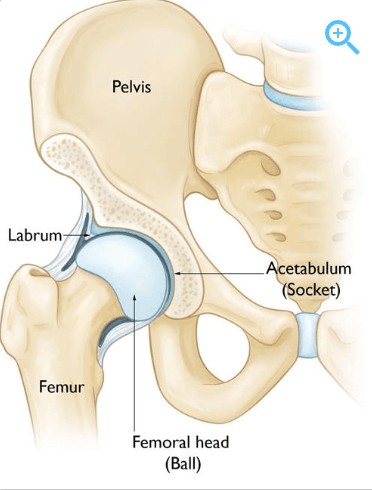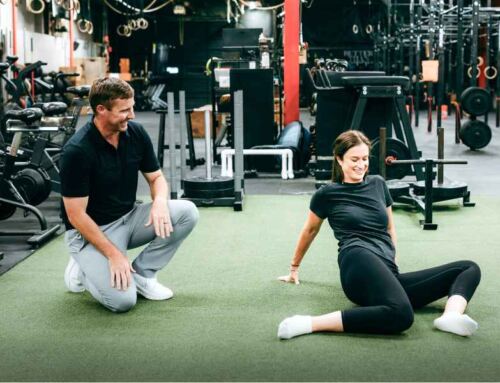How To Fix Hip Pinching While Squatting: Causes & Solutions
Do you experience hip pain when squatting? If you answered yes, you’re in the right place! It is very common for individuals to experience some sort of hip pain when squatting. Some individuals experience a pinching sensation in the front of their hip as they squat down, some may feel a blockage in their hip limiting depth, and some may feel like their pain prevents them from standing back up out of the squat. In this article, I’ll focus on how to address the pinching pain while squatting.
And a quick disclaimer: This article is for informational purposes only and should not replace professional medical advice. Always consult your personal healthcare provider before modifying your movement routines.
What Causes Hip Pain While Squatting?

Image credit: Physiopedia
Some individuals may exhibit poor mechanics when squatting. This is the easiest to fix. Sometimes a few simple adjustments with someone’s form can resolve this pain. Others may have a more permanent issue, like a bony abnormality, that prevents them from achieving full depth, pain free. This is sometimes called Femoral Acetabular Impingement. The hip joint is a ball and socket, but in some individuals either the ball or the socket doesn’t quite sit right. This impingement can limit range of motion due to a physical blockage, or it can create pain with movements like a squat.
What we’ll address most closely here are individuals who are limited or have pain due to tight and/or weak musculature surrounding the hip.
When seeing a physical therapist for pinching hip pain, it’s good to do strength and range of motion assessments of the hip. You can also check joint mobility, core and lower extremity strength, and tissue flexibility of the surrounding musculature. These checks can help determine some potential contributing factors to your hip pain.
How Do You Fix Hip Pain While Squatting?

Image credit: crossfit.com
Before we get to appropriate rehab or accessory exercises, let’s make any necessary adjustments to your squat stance.
A great place to begin is taking a video of yourself squatting, which can be helpful to see where changes need to be made.
There are a few key points of a squat that I believe are crucial to assess, as these factors can affect our ability to successfully squat pain free.
Starting Position
Is your stance during your squat the most appropriate for your body type?
As we sit down into our squat, everyone’s stance will be a little different. Some people may find they can squat deep with a relatively narrow stance, while others may find a wider stance with their feet pointing outward is more comfortable and allows them to sit deeper into their squat.
Your squat stance is something you can play around with and find what is most comfortable and efficient for you.
Proper Knee Tracking
As you sit into your squat, do your knees and toes point in the same direction as your toes?
Regardless of your beginning stance during the squat, it is crucial that you have proper knee tracking as you descend in the squat.
As we squat, it should be our goal to drive our knees in the direction of our 3rd and 4th toe, to prevent our knees from caving inward.
Trunk Position
Do you keep your chest upright without excessive rounding or arching at your low back?
At the bottom of your squat, are you rounding your low back excessively or arching at your low back excessively? This may be indicative of poor abdominal strength or poor mobility in their lumbar or thoracic spine.
“I’ve made these adjustments and still have pain!”
If you still have hip pain after you’ve addressed your stance, it’s a good time to look at a few major mobility, flexibility, and strength issues I commonly find in individuals who experience pinching in their hip while squatting.
I first like to look at factors such as trunk, hip, knee and ankle mobility and flexibility in the surrounding muscles. If someone is particularly stiff in one area, this can lead to compensations during their squat.

Image credit: Physiopedia
In today’s day and age, many people tend to sit for extended periods of time, whether it is when working at a desk or driving on a long commute. This leads many people to have tight hip flexors.
The more time we spend sitting throughout the day, our hip flexors will adaptively shorten to this new position. When a muscle becomes extremely tight, or stiff, it does not lengthen or shorten well.
As you can see in the image above, the hip flexors are the muscles that run across the front of the hip. They perform the motion of hip flexion, which occurs during a straight leg raise, a march, or even a squat. As you squat down, your hip flexors need to shorten/contract, but if the tissue is so tight, this may not be very easy or comfortable, leading to a pinching sensation in the front of the hip. Not only is the hip flexor really tight in this situation, but there is likely a substantial amount of weakness as well.
When a muscle remains in a shortened position, it likely doesn’t have the strength to move through its full, available range of motion. Not only is it important to work on the flexibility here, but we then need to strengthen. If we stretch all day long, but forget to strengthen our hip flexors after, the next day you will be right back where you started. The stronger our muscles are, the more control we will have throughout a movement, like a squat.
Joint Mobility
Another key factor we need to look at is joint mobility. This article solely focuses on the hip, but remember that it’s important to factor in all of the joints above and below that area (knees, ankles, low back, and so on).
Hip rotation is an important measurement we need to take into consideration here. If someone has limited hip internal rotation, this not only may lead to pinching in the hip, but it may lead to a weight shift away from that side when they squat down. In other words, if the right hip internal rotation is stiff, this person may exhibit a weight shift to the left during their squat.
Exercises to Help Hip Pinching When Squatting
That’s the underlying theory! Now let’s look at some exercises that can improve these mobility, strength, or flexibility deficits.
Banded Hip Mobilizations
Banded hip mobilizations are my go-to exercise for someone who has joint mobility issues.
Performing 10 reps of each movement in this video is an excellent way to improve both hip internal and external rotation.
ATG Squat Series
One of my favorite exercises to address tight hip flexors is the ATG Squat Series.
This will help improve flexibility of the hip flexors in a dynamic way, but it will also help improve ankle mobility and strengthen the quadriceps. Perform 2-3 sets of 5 reps of each movement.
Standing Psoas March
After we open up the hip flexors it’s time to strengthen! There are a variety of exercises we can use to strengthen our hip flexors, such as a long sitting straight leg raise and supine psoas marches.
One of my favorites is a Standing Psoas March since it will challenge the working hip flexor while also challenging the stability of the stance leg. Aim for 3 sets of 10 reps here.
Banded Squat
Finally, the most functional exercise to help our squat is with a banded squat!
By placing a band around your shins and keeping tension here while you lower into a squat, this helps you recruit the outer muscles of your hips and create more space for you to squat down into. Aim for 3 sets of 8 reps each.
Please note that if any of these exercises lead to more pain then when you started, please do not perform them.
Conclusion
Squatting is one of the most functional exercises. We need to do it every time we sit down and stand up from any surface, so it’s important that we’re able to do this movement well and pain free!
If you or anyone you know experiences hip pain when squatting, consider these exercises and tips. And if the pain persists or complicates, reach out to a qualified physical therapist to start squatting better, moving better, and living better.
References
- “Hip Shift During Squats.” Barbell Rehab, 3 Sept. 2020, https://barbellrehab.com/hip-shift-during-squats/. Accessed 26 Aug.2024.
- “Femoroacetabular Impingement.” Ortho Info, edited by Jocelyn Ross Witstein, MD, FAAOS et al., Apr.2024, https://orthoinfo.aaos.org/en/diseases–conditions/femoroacetabular-impingement/. Accessed 26 Aug. 2024.
- “Hip muscles anterior aspect.” Physiopedia, https://www.physio-pedia.com/Hip_Flexors. Accessed 25 Aug. 2024.
- “Common Faults: Air Squat.” https://www.crossfit.com/191002. Accessed 24 Aug. 2024.
About the Author
Dr. Cali Pyzdrowski is a physical therapist in the Spring Lake, North Carolina area. She specializes in working with CrossFit athletes and is a Coach and Competitor herself. Among Cali Pyzdrowski’s treatment specialties are orthopedic pain and injuries, and sports injuries. No matter your age or movement styles, Dr. Cali is here to help you move well so you can live better.








